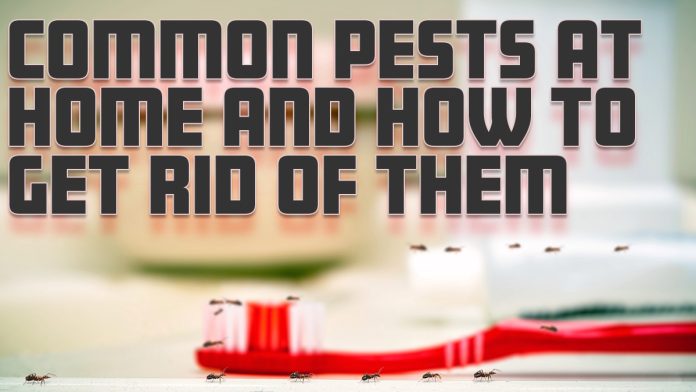Pests have a reputation for being troublesome critters because of their propensity to annoy homes and business owners. Naturally, people will always view pests as unwanted visitors and experience distress and disgust when they discover their home is infested with insects. Their first reaction is to get rid of the bugs as soon as possible.
We, homeowners, utilize a variety of preventive measures to guard against further pest invasion. Unfortunately, our futile attempts to eliminate such annoyances would occasionally fail. Some DIY pest control techniques are only sometimes entirely successful. In addition, despite a single application of pesticides and other treatment alternatives, you can only partially wipe out these pests simultaneously. In truth, some bug species are merely persistent and even resistant to chemical treatments. They also procreate quickly, so an out-of-control infestation may happen before we realize it.
Nature of Household Pests
Pests exist to be a nuisance, which is a clear indication that they need to be eliminated. Pests discover ways to survive, whether spring, summer, fall, or winter. They’ll constantly have a spot to hide, hibernate, and prosper. Therefore, you are mistaken if you believe there will ever be a day that you can stop dealing with the difficulty and tension that pests cause. Keep your wits about you since bugs can survive despite the harsh conditions they may encounter in their native home. To get the warmth, shelter, food, and water they require, they will always turn to occupy locations like your house.
While some pests continue to be a problem in the United States year-round, others are more active than usual during a particular season. Among the most prevalent domestic pests are ants, cockroaches, rodents, bed bugs, mosquitoes, fleas, spiders, termites, flies, stink bugs, stinging insects, and even pigeons. Even though we frequently see them, we should recognize the threat they could pose. Unfortunately, getting rid of an infestation is a difficult task that calls for experience.
Importance of Pest Control
Homeowners must enlist the assistance of a pest control specialist in cases of severe pest infestations. Termite treatment, heat treatment, cockroach removal, rat control, and ant control, among other services, are just a few of the many pest control businesses provide. We have every incentive to want to get rid of pests for good as soon as possible, considering the harm they cause to our lives. As homeowners, we are responsible for understanding the value of professional pest management and taking the required precautions to safeguard our dwelling from the damage a pest infestation may cause.
Common Home Pests
Here’s a list of common pests that find sanctuary inside people’s dwellings:
1. Ants.
- The most prevalent ant species particularly active in spring and summer are pavement ants and carpenter ants. Carpenter ants create nests inside the wooden parts of your home, endangering its structural stability just like termites do. Although pavement ants are typically spotted outside, they can enter our home if they are scavenging for food. House ants are another species that might cause problems during this time of year. Typically, these bugs live in wet places near sinks and bathrooms. Ants primarily seek refuge indoors to scavenge for food and water supplies and look for sources of warmth.
2. Mosquitos.
- The warmest places are where mosquitoes like to hang around. These insects are among the most dangerous ones that spread lethal diseases, including the Zika virus, dengue fever, malaria, etc. Mosquitoes thrive and breed in moist environments, especially those with stagnant water (i.e., buckets, gutters, downspouts, and puddles). Keeping the area dry and devoid of standing water will stop mosquitoes from flourishing.
3. Roaches.
Roaches can survive all year round, but they prefer moist interior surroundings, so the sun’s warmth will not benefit them. Expect cockroaches to crawl all over your home during hot weather. These repulsive creatures will hide in and near trash bins, sewers, and locations on your property where warmth, moisture, and food are plentiful during cooler weather.
4. Stink bugs.
- As their name suggests, stink bugs have a defense mechanism they employ when they sense danger. They emit a smell that is very potent and offensive to the senses. The good news is that they are typically safe, given that they don’t spread infections. They, nonetheless, enter your home in search of warmth and light. If you are experiencing stink bug infestation, ATC is here to assist you in regaining your peace of mind through our high-quality stink bug extermination in Stewartstown, PA.
5. Bed bugs.
It’s well-known that bed bugs make terrific hitchhikers. They can easily attach themselves to passengers’ clothes and luggage and move residences covertly. These pesky animals will quickly increase in number once they get access to your house, and you won’t even notice. Most of the time, people become aware that they have bed bugs in their homes after the infestation is already severe. Bed bugs are driven to sweat and carbon dioxide and feed on human blood to survive, so they stay close to people, especially at night.
6. Termites.
- Termites are notorious for seriously compromising the structural integrity of a home or building. They consume the cellulose found in dead trees or wood. Because of this, they infest the house’s walls, floors, ceilings, and furnishings. A termite infestation needs to be addressed right away.
7. Pigeons.
- Pigeons also become a nuisance for building proprietors and homeowners during the fall, for it is another peak season for mating. Pigeon control is making potential nesting and roosting places of these animals uninviting and, to the fullest extent, eliminating pigeon feeding.
8. Spiders.
- Like other insects, these arachnids become more active in the spring, especially in the chilly, gloomy areas of the house. Most home spiders are safe. However, we must avoid the Brown and the Black Widow Recluse, for these are deadly species. It is recommended that homeowners cover or seal any cracks and openings in their homes and maintain a dry, clean environment.
Ways to Keep Home Pests Out
The best action is always to contact a pest control expert when an infestation becomes unmanageable. When it comes to identifying pests and carrying out the proper treatment method, pest control firms have the necessary equipment and expertise. They provide high-quality, long-lasting solutions and services, including termite elimination, rodent control, and bed bug extermination. However, you can take the following actions to help lessen the effects of your insect problem and deter bugs from returning:
1. Eliminate all of their hiding and spawning places.
There are several places where bugs can grow and breed, which is one reason why they still hang around your house. Taking away their hiding places will therefore decrease their chances of surviving. Clutter gives bugs more places to hide and dwell, such as disused things, empty boxes, and outdated newspapers. You can keep those horrible creatures at bay if you clear away extra debris and other potential breeding areas like standing water.
2. Regularly clean and vacuum your surroundings at home.
The most effective strategy to stop pests from seeking refuge inside your home is to keep your environment tidy and free from clutter. This requires daily trash disposal and instantly cleaning up messes and food spills. Flies, rodents, and cockroaches are less likely to remain on your property if they can’t smell food or rubbish. Another helpful strategy is vacuuming, which can remove dust and debris. The vacuum can also suck out naughty insects that hide in crevices, furniture, bedding, and upholstery. Just be careful to toss the vacuum bag into an outdoor trash can far from your home as soon as you’re through cleaning.
3. Use screens and seal any openings.
Installing screens on your windows and doors prevents pests from entering your home. Additionally, it would be best if you sealed off any gaps, holes, or cracks in the structure or on the walls. Entrance points can be sealed or caulked to keep pests out permanently. To block possible entryways for problems, you must repair any damage to your home’s plumbing and structural components. Pests won’t be able to enter your home on their own if you don’t allow them any opportunities.
4. Observe correct pesticide usage procedures.
Be aware that utilizing pesticides ought to be a last resort. Take into account the following advice before using pesticides:
- Make sure you apply the insecticide designed precisely for the bugs you are battling. Not all insecticides are effective against all bug species. You could harm or destroy other helpful creatures at home if you are not careful. Therefore, you must read the instructions on the pesticide bottle’s back.
- Seek professional advice. Pest control professionals can guide you on the proper use, application, and dosage of pesticides.
- Always keep insecticides out of the reach of children and store them in properly labeled containers.
Protection Against Pests Begins at Home
Pests are constantly looking for ways to get inside your house. Therefore, it is the responsibility of every homeowner to protect, fix, and prevent entry points such as fissures, cracks, tears in the screen, and other structural flaws. Most importantly, speaking with a pest control expert is the best course of action for advice on pest prevention techniques.






